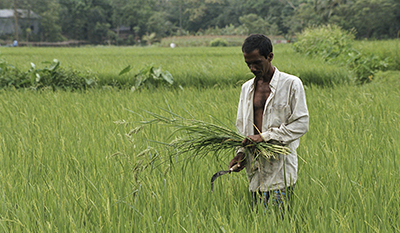Research Brief
Food security in Bangladesh
Global food price hikes during 2007-08 resulted in a sharp rise in staple food prices in Bangladesh, which in turn led to a significant rise in the number of households falling below the poverty line. On the political front, Bangladesh was run by an unelected and undemocratic ‘civil’ caretaker government, backed by the military, which remained in power until the end of 2008 and undertook several steps to contain price hikes. Some of these policies and programmes were effective. Some were not.
In response to the food price hike during 2007-08 the government of Bangladesh undertook a number of initiatives to promote agricultural development, including:
- a subsidy on fertilizer
- endowment funds for agricultural research and development
- cash incentives for exporting agricultural products
Increasing imports of rice proved difficult due to India’s ban on rice exports and high international prices
The government’s ability to respond to the food price crisis was also limited by a lack of machinery, personnel, and administrative capacity
The importance of rice
Food security in Bangladesh is strongly linked to the production, import, and price stability of rice. Bangladesh is a net rice‐importing country, but rice imports in Bangladesh have traditionally been erratic, depending on domestic production, which is often affected by natural calamities. Self‐sufficiency in rice production has long been a national objective. With expanded cultivation of high‐yielding paddy varieties, the once critical dependence on imports has subsided.
Human-caused and natural calamities threaten food security
Since independence in 1971, Bangladesh has faced a number of human‐caused and natural calamities that have threatened the food security of poor and marginalized people. These calamities include a famine in 1974, floods in 1987 and 1988, a cyclone in 1991, a flood in 1998, and a cyclone in 2007. The government responded to these crises by supplying food for immediate relief and by helping to coordinate food aid commitments and deliveries. At the same time, as part of its price stabilization strategy, the government encouraged private sector imports—a policy that helped avoid food shortages.
Policy measures in response to the food price hike during 2007–08
The government undertook a number of initiatives to promote agricultural development, including:
- a subsidy on fertilizer
- a rehabilitation programme for people affected by floods and cyclones
- endowment funds for agricultural research and development
- a subsidy on diesel fuel for small and marginal farmers
- cash incentives for exporting agricultural products
- rebates on electricity bills for entrepreneurs of agro‐based industries
- reduced interest rates for loans for the production of pulses, oil seeds, and spices
- distribution of agricultural and rural credit through state-owned commercial banks
- total operative tariffs on rice and wheat were reduced to zero
- the annual renewal fee for value‐added tax (VAT) registration by commercial importers was withdrawn.

The government also arranged distribution of food grains through various safety net programmes, strengthened distribution of rice and pulses to the poor through Bangladesh Rifle’s Dal‐Bhat programme, and increased the coverage and amount of individual grants under social safety net programmes. The central bank expanded agricultural credit, facilitated the distribution of subsidies on agricultural inputs, and provided soft loans for new importers of food items.
The central bank followed a moderately contractionary monetary policy and intervened in foreign exchange markets directly and indirectly to keep a stable exchange rate against the US dollar.
Ineffective government actions
Though the government decided to intensify internal procurement of food grains, in reality total procurement was much lower than targeted procurement. This shortfall was due to production losses caused by natural disasters and the fact that prevailing market prices were higher than the government’s procurement prices. The government was unable to meet the shortfall in domestic procurement through higher imports from the world market because India had banned rice exports in October 2007, and because the world market price of rice was much higher than the domestic price which discouraged private importers. The Ministry of Commerce (MoC) and the Ministry of Food and Disaster Management (MoFDM) were at the center of discussions on the government’s response. The MoC formed a Price Monitoring Cell (PMC), but, lacking required machinery, personnel, and capacity, the PMC failed to exert any influence over market prices. An attempt to empower the Trading Corporation of Bangladesh (TCB)—a public agency organization under the MoC—as a market player during the price hike was ineffective owing to lack of resources.
Though the MoC and MoFDM were at the center of the discussions, they had no direct power to influence domestic market prices. The MoC had no direct authority to lower import duties on food items; it had to request such a decision by the Ministry of Finance (MoF). There were also important non‐economic reasons for the food price hike in the domestic market, such as extortion and unofficial payments in transportation, distribution, and marketing channels. These problems required action from the Ministry of Home Affairs. Through the Ministry of Home Affairs, the caretaker government took a number of measures to combat the non‐economic factors and drove actions against illegal and informal supply chains. However, while some of the measures against extortion were effective, many of the actions against illegal and informal supply chains were counterproductive.
The role of other stakeholders
The business community urged the central bank to ensure that administrative prices of fuel, utilities, and fertilizers not be increased. They opposed the central bank’s tight monetary policy because it might raise entrepreneurs’ borrowing costs, curb enthusiasm for investing in the formal economy, and slow economic growth. These calls from the business community did not lead the central bank to reverse its monetary policy stance, a stance supported by the International Monetary Fund. Civil society organizations called for widening the scope of social safety net programmes. Newspapers published key news, information, and analysis, and were major means for disseminating government decisions and policy actions, as well as the reactions of stakeholders.
 Join the network
Join the network